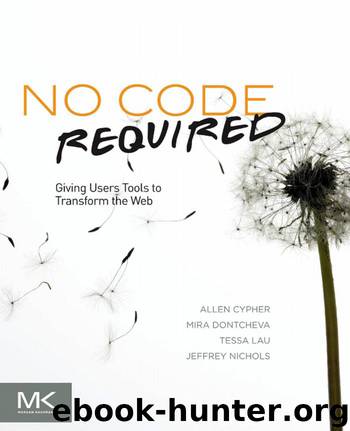No Code Required by Cypher Allen Lau Tessa Dontcheva Mira Nichols Jeffrey

Author:Cypher, Allen, Lau, Tessa, Dontcheva, Mira, Nichols, Jeffrey
Language: eng
Format: epub
Publisher: Elsevier Science
DISCUSSION
The interaction techniques embodied in the Web Summaries system enable users to transform the Web into their own personal Web that provides personalized access to the information they care about in the form of their choosing. First, we take advantage of the growth in template material on the Web and design semiautomatic interactive extraction of content from similar Web pages using structural and content extraction patterns. Second, we employ layout templates and user labeling to create rich displays of heterogeneous Web content collections. Third, we use search technology for proactive retrieval of content from different related Web sites through user-defined relations. Fourth, we let users define their own personalized and aesthetic views of heterogeneous content from any number of Web sites through cards. And finally, we introduce a new template-based search paradigm that combines the user-defined relations and cards into a search template. Search templates present a goal-driven search mechanism that creates visual personalized summaries of the content users need to accomplish their task. As users accomplish their goals with these tools, they also produce artifacts, such as the extraction patterns and relations that are persistent and sharable. These artifacts can be stored in a public repository and reused by others. Furthermore, they can be added to the Web sites where they originated, thereby enhancing the existing Web with semantic information, such as relationships between different Web sites or the types of content available in a particular Web page. If popularized by an online community, the ideas we present here can help realize a machine-readable World Wide Web.
To better understand how the Web Summaries system works in practice and to test how it would interact with an online community for sharing extraction patterns, we deployed the system for 10 weeks with 24 participants. Here we present the main conclusions from this field study. For more details, please see (Dontcheva et al., 2008).
Our study revealed that users collect a variety of Web content including highly structured content, such as tables and lists, and highly unstructured content, such as entire articles. Our participants actively used automatic retrieval on many Web sites and for their own personal tasks. They created over 250 extraction patterns by clipping pieces of Web pages and collected over 1000 items automatically. Though Web Summaries was useful for content-intensive tasks, users found it less applicable for transient daily tasks, because the tool required opening a summary window and actively saving content. Many participants also used Web Summaries as a mechanism for storing permanent versions of Web content that they view as highly dynamic. The participants were very positive about the layout templates and the resulting summaries. They used a variety of layout templates and requested more flexible customizable templates. Finally, the participants used a community pattern repository to download patterns created by others. They often modified downloaded patterns to suit their own needs. They suggested many improvements to the interface to help make sharing patterns as fast and easy as creating them through clippings.
These findings lead us to the
Download
This site does not store any files on its server. We only index and link to content provided by other sites. Please contact the content providers to delete copyright contents if any and email us, we'll remove relevant links or contents immediately.
| Content Management | Programming |
| User Experience & Usability | User Generated Content |
| Web Design | Web Marketing |
| Web Services | Website Analytics |
Hello! Python by Anthony Briggs(9373)
The Mikado Method by Ola Ellnestam Daniel Brolund(9307)
Dependency Injection in .NET by Mark Seemann(8859)
Sass and Compass in Action by Wynn Netherland Nathan Weizenbaum Chris Eppstein Brandon Mathis(7402)
The Well-Grounded Java Developer by Benjamin J. Evans Martijn Verburg(7116)
Secrets of the JavaScript Ninja by John Resig & Bear Bibeault(6249)
Secrets of the JavaScript Ninja by John Resig Bear Bibeault(5957)
Jquery UI in Action : Master the concepts Of Jquery UI: A Step By Step Approach by ANMOL GOYAL(5512)
Kotlin in Action by Dmitry Jemerov(4637)
Audition by Ryu Murakami(4099)
Hands-On Full-Stack Web Development with GraphQL and React by Sebastian Grebe(3883)
Functional Programming in JavaScript by Mantyla Dan(3723)
Svelte with Test-Driven Development by Daniel Irvine(2893)
Learning React: Functional Web Development with React and Redux by Banks Alex & Porcello Eve(2837)
WordPress Plugin Development Cookbook by Yannick Lefebvre(2600)
Architecting Modern Java EE Applications: Designing lightweight, business-oriented enterprise applications in the age of cloud, containers, and Java EE 8 by Daschner Sebastian(2558)
Layered Design for Ruby on Rails Applications by Dementyev Vladimir;(2507)
Test-Driven Development with PHP 8 by Rainier Sarabia(2490)
React Native - Building Mobile Apps with JavaScript by Novick Vladimir(2339)
